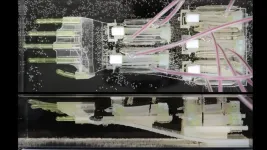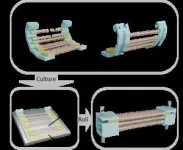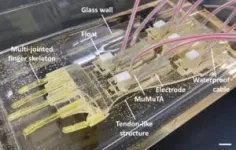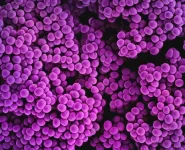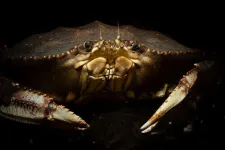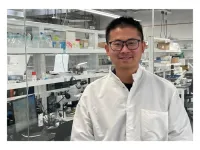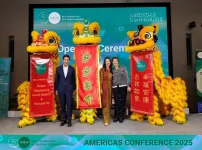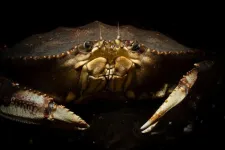(Press-News.org) A biohybrid hand which can move objects and do a scissor gesture has been built by a team at the University of Tokyo and Waseda University in Japan. The researchers used thin strings of lab-grown muscle tissue bundled into sushilike rolls to give the fingers enough strength to contract. These multiple muscle tissue actuators (MuMuTAs), created by the researchers, are a major development towards building larger biohybrid limbs. While currently limited to the lab environment, MuMuTAs have the potential to advance future biohybrid prosthetics, aid drug testing on muscle tissue and broaden the potential of biohybrid robotics to mimic real-life forms.
“Rock, paper, scissors” is a classic schoolyard game or quick-fire way to make decisions for the indecisive. But choose paper and you are going to lose to this robot hand, which has mastered the art of the scissor gesture. And while it might seem like a simple motion, in the realm of biohybrids and prosthetic limbs, this is a leap forward towards new levels of realism and usability.
The hand is made of a 3D-printed plastic base, with tendons of human muscle tissue which move the fingers. Until now, biohybrid devices have typically been on a much smaller scale (about 1-centimeter long) or limited to simpler or single-joint movements. By contrast, the biohybrid hand is 18 cm in length and has multijointed fingers, which can be moved individually to make gestures or in combination to manipulate objects.
“Our key achievement was developing the MuMuTAs. These are thin strands of muscle tissue grown in a culture medium and then rolled up into a bundle like a sushi roll to make each tendon,” explained Professor Shoji Takeuchi from the University of Tokyo. “Creating the MuMuTAs enabled us to overcome our biggest challenge, which was to ensure enough contractile force and length in the muscles to drive the hand’s large structure.”
Thick muscle tissue which is needed to move larger limbs is difficult to grow in the lab, as it suffers from necrosis. This is when insufficient nutrients reach the center of the muscle, resulting in tissue loss. However, by using multiple thin muscle tissues bundled together to act as one larger muscle, the team was able to create tendons with enough strength.
The MuMuTAs are stimulated using electrical currents, delivered through waterproof cables. To test the abilities of the hand, the team manipulated the fingers to form a scissor gesture by contracting the little finger, ring finger and thumb. They also used the fingers to grasp and move the tip of a pipette. This demonstrated the hand’s ability to mimic a range of actions, as the multijointed fingers can be flexed either separately or at the same time, an impressive feat.
Using real muscle tissue does however come with some downsides, as anyone who has been to the gym may know. “While not entirely surprising, it was interesting that the contractile force of the tissues decreased and showed signs of fatigue after 10 minutes of electrical stimulation, yet recovered within just one hour of rest. Observing such a recovery response, similar to that of living tissues, in engineered muscle tissues was a remarkable and fascinating outcome,” said Takeuchi.
Currently the hand must be suspended in liquid so that the “anchors,” or ties, which connect the muscles to the hand can float without friction, allowing the fingers to move smoothly. However, the team believes that with further development, it will be possible to build a free-moving hand.
Another further challenge with the current design is that the fingers cannot be intentionally returned to their straight starting position but do so by floating into place. Adding an elastic material to snap them back into position, or more MuMuTAs on the back of the fingers which contract in the opposite direction, would enable more control over finger movement.
“A major goal of biohybrid robotics is to mimic biological systems, which necessitates scaling up their size. Our development of the MuMuTAs is an important milestone for achieving this,” said Takeuchi. “The field of biohybrid robotics is still in its infancy, with many foundational challenges to overcome. Once these basic hurdles are addressed, this technology could be used in advanced prosthetics, and could also serve as a tool for understanding how muscle tissues function in biological systems, to test surgical procedures or drugs targeting muscle tissues.”
########
Paper
X. Ren, Y. Morimoto and S. Takeuchi. Biohybrid hand actuated by multiple human muscle tissues. Science Robotics. February 12th 2025. DOI: TBC
Funding:
This work was supported by ST-Mirai Program JPMJMI20C1, JST Fusion Oriented Research for Disruptive Science and Technology JPMJFR222Q, JSPS KAKENHI Grant Number JP21H05013 and the UTEC-UTokyo FSI Research Grant Program.
Conflicts of interest:
The authors declare no competing interests.
Useful Links:
Graduate School of Information Science and Technology: https://www.i.u-tokyo.ac.jp/index_e.shtml
T Lab: https://www.hybrid.t.u-tokyo.ac.jp/en/
[Press release, January 2024] “Shuffling robot uses biological muscle to move and spin”: https://www.u-tokyo.ac.jp/focus/en/press/z0508_00329.html
[Press release, June 2022] “Robot skin heals”: https://www.u-tokyo.ac.jp/focus/en/press/z0508_00225.html
[Press release, January 2021] “How does your computer smell”: https://www.u-tokyo.ac.jp/focus/en/press/z0508_00159.html
Research Contact:
Professor Shoji Takeuchi
Department of Mechano-Informatics,
Graduate School of Information Science and Technology,
The University of Tokyo, 7-3-1 Hongo Bunkyo-ku, Tokyo 113-8656, Japan.
Email: takeuchi@hybrid.t.u-tokyo.ac.jp
Press contact:
Mr Rohan Mehra
Public Relations Group, The University of Tokyo,
7-3-1 Hongo, Bunkyo-ku, Tokyo 113-8654, Japan
press-releases.adm@gs.mail.u-tokyo.ac.jp
About the University of Tokyo
The University of Tokyo is Japan’s leading university and one of the world’s top research universities. The vast research output of some 6,000 researchers is published in the world’s top journals across the arts and sciences. Our vibrant student body of around 15,000 undergraduate and 15,000 graduate students includes over 4,000 international students. Find out more at www.u-tokyo.ac.jp/en/ or follow us on X (formerly Twitter) at @UTokyo_News_en.
END
Biohybrid hand gestures with human muscles
Complex finger movements made possible with rolls of tendonlike human muscle tissue
2025-02-12
ELSE PRESS RELEASES FROM THIS DATE:
Diabetes can drive the evolution of antibiotic resistance
2025-02-12
Antibiotics are powerful, fast-acting medications designed to eradicate bacterial infections. However, in recent years, their dependability has waned as antibiotic resistant bacteria continues to evolve and spread.
Staphylococcus aureus is a leading cause of antibiotic resistance associated infections and deaths. It is also the most prevalent bacterial infection among those with diabetes mellitus, a chronic condition that affects blood sugar control and reduces the body’s ability to fight infections.
Microbiologists Brian Conlon, PhD, and Lance Thurlow, PhD, at the UNC School of Medicine have just shown that people with diabetes are more likely to develop antibiotic-resistant ...
ChatGPT has the potential to improve psychotherapeutic processes
2025-02-12
When it comes to comparing responses written by psychotherapists to those written by ChatGPT,the latter are generally rated higher, according to a study published February 12, 2025, in the open-access journal PLOS Mental Health by H. Dorian Hatch, from The Ohio State University and co-founder of Hatch Data and Mental Health, and colleagues
Whether machines could be therapists is a question that has received increased attention given some of the benefits of working with generative artificial intelligence (AI). Although previous research has found that humans ...
Prioritise vaccine boosters for vulnerable immunocompromised patients and prevent emergence of new COVID variants, say scientists
2025-02-12
Vaccinations alone may not be enough to protect people with compromised immune systems from infection, even if the vaccine has generated the production of antibodies, new research from the University of Cambridge has shown.
The findings, published today in Science Advances, suggest that such individuals will need regular vaccine boosters to protect them and reduce the risk of infections that could be severe and also lead to new ‘variants of concern’ emerging.
Almost 16 million people worldwide are estimated ...
California's most economically and culturally important species among those most vulnerable to projected climate change
2025-02-12
California's most economically and culturally important species among those most vulnerable to projected climate change, per Climate Vulnerability Assessment of 34 marine species.
###
Article URL: https://plos.io/4gslT5s
Article Title: A collaborative climate vulnerability assessment of California marine fishery species
Author Countries: U.S.
Funding: This work was funded by a grant from the Resource Legacy Fund (#15067). Though the funders helped determine the project's initial scope of work, they had no role in data collection and analysis, the decision to publish, or the preparation of the manuscript. END ...
Scientists develop novel self-healing electronic skin for health monitoring
2025-02-12
Los Angeles, CA – February 12, 2025—Researchers have achieved a breakthrough in wearable health technology by developing a novel self-healing electronic skin (E-Skin) that repairs itself in seconds after damage. This could potentially transform the landscape of personal health monitoring.
In a study published in Science Advances, scientists demonstrate an unprecedented advancement in E-Skin technology that recovers over 80% of its functionality within 10 seconds of being damaged – a dramatic improvement over existing technologies that can take minutes or hours to heal.
The technology seamlessly combines ultra-rapid self-healing capabilities, reliable ...
Models show intensifying wildfires in a warming world due to changes in vegetation and humidity; only a minor role for lightning
2025-02-12
Extreme fire seasons in recent years highlight the urgent need to better understand wildfires within the broader context of climate change. Under climate change, many drivers of wildfires are expected to change, such as the amount of carbon stored in vegetation, rainfall, and lightning strikes. Quantifying the relative importance of these processes in recent and future wildfire trends has remained challenging, because previous climate computer model simulations did not capture the full coupling between climate change, lightning, wildfires, smoke and corresponding shifts in solar ...
Unraveling the complex role of climate in dengue dynamics
2025-02-12
The research team led by KIM Jae Kyoung, Professor in the Department of Mathematical Sciences at KAIST and Chief Investigator of the Biomedical Mathematics Group at the Institute for Basic Science (IBS), has unveiled new insights into how weather influences the spread of dengue fever. Their study identifies temperature and rainfall as critical factors driving the global surge in dengue cases and offers actionable strategies for mitigating the disease's impact.
Dengue fever, a mosquito-borne disease, poses an increasingly alarming public health challenge. According to the World Health Organization, reported dengue cases surged from 4.1 ...
INSEAD celebrates five years of impact in North America during its second Americas Conference 2025
2025-02-12
INSEAD, The Business School for the World, celebrated five years of impact of its San Francisco Hub for Business Innovation during its second Americas Conference 2025 on 7-8 February.
Over 250 business leaders, government officials, INSEAD alumni, faculty, and staff convened for insightful and lively conversations centered around the theme: ‘The Future is Now: Bridging Business, Technology, and Humanity’.
The central question driving all the debates was: How can we harness the incredible potential of AI while prioritizing the well-being of humanity. Key themes that emerged included the ability for leaders to see beyond AI hype, a need to embrace disruption, ...
MAGE-4 promotes tumor progression by halting antitumor responses
2025-02-12
A study published in Science Advances reveals a novel strategy that allows tumors to evade the body’s immune response critical for their elimination. Researchers at Baylor College of Medicine and collaborating institutions discovered in a mouse model of non-small cell lung cancer that tumors that express protein MAGE-4 and have lost the Pten gene, a tumor suppressor, accelerate their development and progression into metastasis. In the mouse model and human tumor samples, MAGE-4 drives the accumulation of plasma immune cells that suppress antitumor immunity. The study points at novel potential therapeutic ...
Economically, culturally important marine species vulnerable to changing climate, new study shows
2025-02-12
Dungeness crab, Pacific herring, and red abalone are among the marine species most vulnerable to the changing climate's effect on California's coastal waters, a new study led by UC Santa Cruz researchers finds. In a paper published on February 12 in the journal PLOS Climate, the team seeks to help the California Department of Fish and Wildlife (CDFW) in its efforts to develop and implement climate-ready fisheries management strategies that adapt to challenges such as rising ocean temperatures, acidification, and deoxygenation.
The study, "A Collaborative Climate Vulnerability Assessment of California Marine Fishery Species," was led by Timothy Frawley, an assistant ...
LAST 30 PRESS RELEASES:
Norbert Holtkamp appointed director of Fermi National Accelerator Laboratory
New agentic AI platform accelerates advanced optics design
Biologists discover neurons use physical signals — not electricity — to stabilize communication
Researchers discover that a hormone can access the brain by hitchhiking
University of Oklahoma researcher awarded funding to pursue AI-powered material design
Exploring how the visual system recovers following injury
Support for parents with infants at pediatric check-ups leads to better reading and math skills in elementary school
Kids’ behavioral health is a growing share of family health costs
Day & night: Cancer disrupts the brain’s natural rhythm
COVID-19 vaccination significantly reduces risk to pregnant women and baby
The role of vaccination in maternal and perinatal outcomes associated with COVID-19 in pregnancy
Mayo Clinic smartwatch system helps parents shorten and defuse children's severe tantrums early
Behavioral health spending spikes to 40% of all children’s health expenditures, nearly doubling in a decade
Digital cognitive behavioral treatment for generalized anxiety disorder
Expenditures for pediatric behavioral health care over time and estimated family financial burden
Air conditioning in nursing homes and mortality during extreme heat
The Alps to lose a record number of glaciers in the next decade
What makes a good proton conductor?
New science reporting guide published for journalists in Bulgaria
New international study reveals major survival gaps among children with cancer
New science reporting guide published for journalists in Turkey
Scientists develop a smarter mRNA therapy that knows which cells to target
Neuroanatomy-informed brain–machine hybrid intelligence for robust acoustic target detection
Eight SwRI hydrogen projects funded by ENERGYWERX
The Lundquist Institute and its start-up company Vitalex Biosciences Announces Strategic Advancement of Second-Generation fungal Vaccine VXV-01 through Phase 1 Trials under $40 Million Competitive Con
Fine particles in pollution are associated with early signs of autoimmune disease
Review article | Towards a Global Ground-Based Earth Observatory (GGBEO): Leveraging existing systems and networks
Penn and UMich create world’s smallest programmable, autonomous robots
Cleveland researchers launch first major study to address ‘hidden performance killer’ in athletes
To connect across politics, try saying what you oppose
[Press-News.org] Biohybrid hand gestures with human musclesComplex finger movements made possible with rolls of tendonlike human muscle tissue
